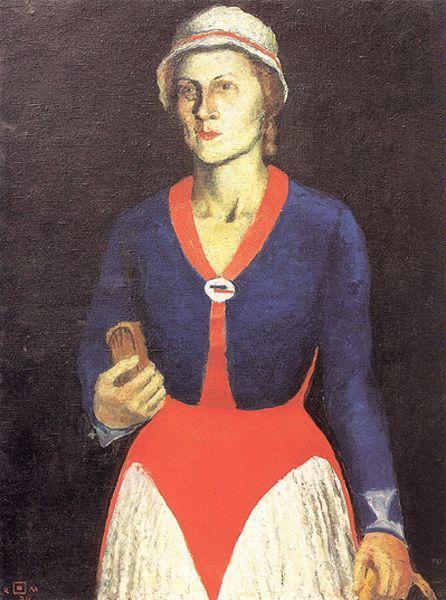Description
The work of Kazimir Malevich's wife, made in 1934, is presented as an eloquent testimony of the artist's ability to merge his innovative visual language with a deep human perception. In this painting, Malevich, whose background in suprematism established it as one of the pioneers of abstract art, shows its versatility when returning to a more figurative way without abandoning the uniqueness of its style.
The portrained figure, the artist's wife, occupies the center of the composition, embodying both the muse and the icon of an era in Malevich's life. The representation is direct and static, but that apparent statism is broken with the vibrant interaction of forms and colors that give life to the portrait. The face of the woman, severe and enigmatic, is delineated with strokes that reflect the influence of Cubism and Russian popular art, both present in the stylistic evolution of the artist. The eyes, slightly almond, seem to look at the viewer with a mixture of determination and melancholy, an ambiguity that invites a stopped contemplation.
The use of color in this work is also worthy of mention. Malevich opts for a palette of terrible and off tones, in contrast to the bright colors of their suprematist compositions. The soft skin tones and the woman's dress are complemented by the simple neutral color background, which allows the figure to emerge with a shocking clarity. The technique, although less rigorously geometric than its previous work, continues to show meticulous care in the disposition of the plans and volumes, suggesting an almost sculptural three -dimensionality.
The choice to represent his wife, not only as a wife but as an archetypal figure, can be interpreted as a symbol of stability and intimacy in a period of socio -political and personal transformations. Malevich, who had been a fervent defender of abstraction, shows in this portrait a partial reconciliation with the human figure and a more introspective exploration.
The historical context in which Malevich created this work also provides a significant nuance. In 1934, the Soviet Union was consolidating its control over various forms of artistic expression, promoting socialist realism as an official style. This period of repression and change meant that artists like Malevich had to adapt to new realities without losing their artistic identity. The work, therefore, can be seen not only as an intimate portrait, but also as a silent declaration of personal resistance and the continuity of the creative spirit in the face of time adversities.
In summary, the portrait of Malevich's wife is a work that captures a temporary synthesis between his suprematist past and an incipient future in which figures and faces return to collect prominence. It is a piece that, although contained in its expression, speaks of the universality of human gesture and the resilience of art against historical currents. This portrait, since its silent presence, invites viewers to reflect on the reach and depth of Kazimir Malevich's legacy.
KUADROS ©, a famous paint on your wall.
Hand-made oil painting reproductions, with the quality of professional artists and the distinctive seal of KUADROS ©.
Art reproduction service with satisfaction guarantee. If you are not completely satisfied with the replica of your painting, we refund your money 100%.

